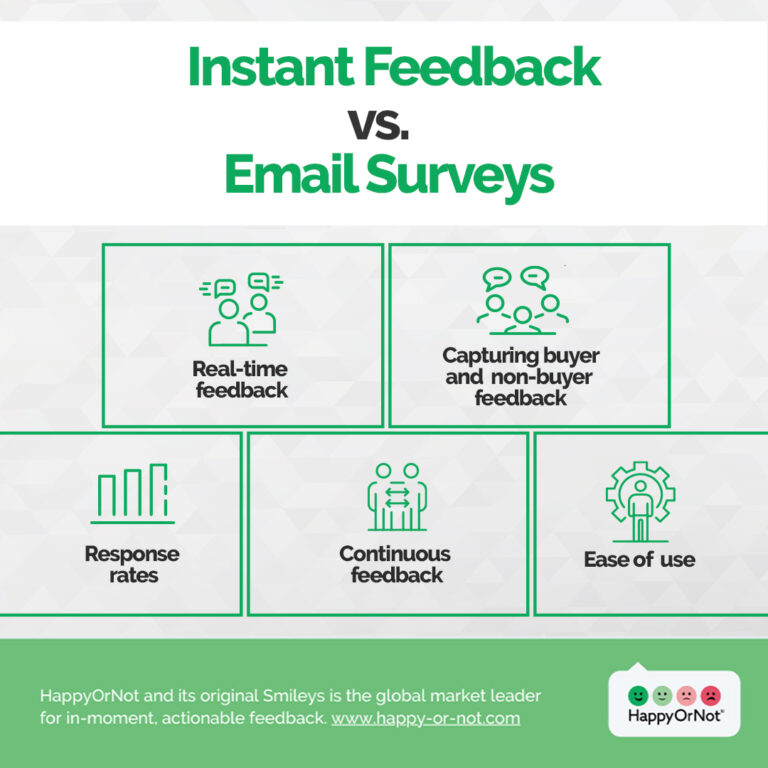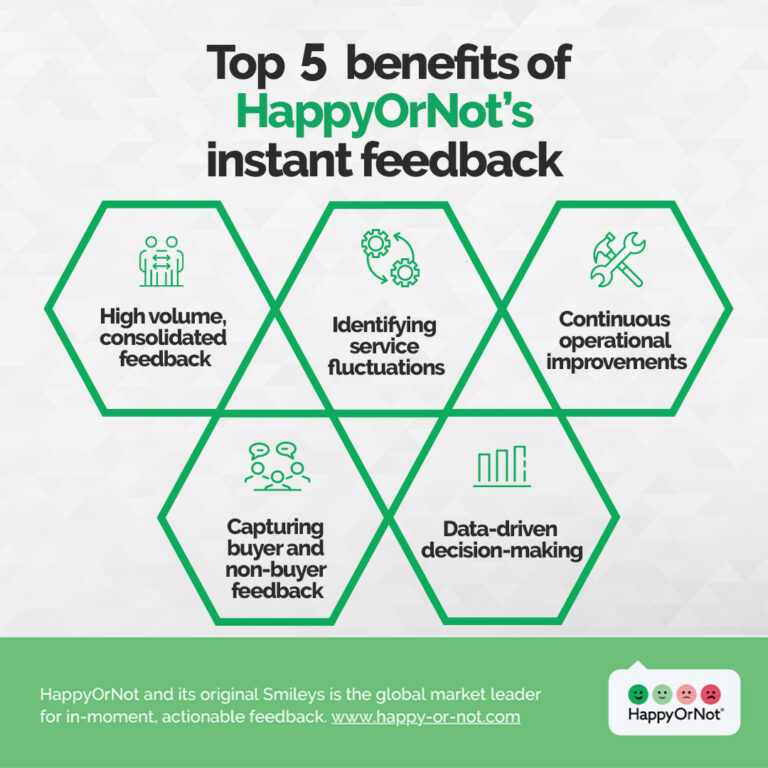HappyOrNot instant feedback vs. email surveys – how do we compare?
Customer feedback has become more critical than ever for businesses striving to improve their services. The instant feedback system and traditional email surveys are two popular methods for collecting valuable insights.
In this blog post, we’ll compare these two feedback-gathering approaches, weighing the pros and cons of each.
What is HappyOrNot instant feedback?
HappyOrNot instant feedback is a powerful tool that enables businesses to capture the immediate perception of their service performance. With the simple push of a button, customers can share their satisfaction level along any physical and digital touchpoint of their interaction with a brand, allowing companies to gauge their performance in real time.
This real-time data catalyzes quick and effective operational enhancements. With instant feedback, businesses can pinpoint specific issues, address customer concerns swiftly, and make data-driven decisions to improve service quality and brand experience.
What are email surveys?
This survey method involves sending a survey directly to customers via email, allowing businesses to request and collect feedback following a transaction. Email surveys provide a simple means to understand your customers’ satisfaction levels and areas for improvement.
These email surveys are a good option for companies looking to enhance their existing customer-base’s experiences.
Instant feedback vs. email surveys
In customer feedback, the choice between instant feedback and email surveys can significantly impact the quality and authenticity of the responses received.
Here are the differences between instant feedback and email surveys and how each influences the sincerity of the feedback collected.

Real-time feedback
Instant feedback, as the name suggests, captures customer sentiments during interaction at any given touchpoint along the customer journey. Whether a smiley-face terminal at a retail store, airport, healthcare clinic, etc., or a digital survey after an online purchase, this method capitalizes on the immediate post-interaction emotions.
The beauty of in-the-moment feedback lies in its ability to gather genuine and unfiltered opinions. Customers are more likely to express their true feelings when their experience is still fresh. This immediacy can result in a wealth of honest feedback that reflects the actual state of customer satisfaction and brand experience.
Capturing buyer and non-buyer feedback
Another distinct advantage of instant feedback is its inclusivity. Unlike email surveys, which often target existing customers, in-moment feedback solutions collect input from buyers and non-buyers. This broader perspective is invaluable for businesses seeking insights beyond their current clientele.
By reaching out to non-buyers, you can uncover valuable feedback from potential customers who may have opted not to purchase. Their opinions can shed light on areas that need improvement, potentially converting them into future buyers.
Response rates
One of the persistent challenges of email surveys is low response rates. Inboxes are often cluttered with messages, and survey requests can easily be overlooked or dismissed. In contrast, instant feedback solutions like HappyOrNot yield significantly higher response rates.
The ease of providing feedback in real-time, often with a single touch or click, encourages customers to participate. They’re more likely to share their thoughts when made easy and convenient, resulting in more responses. This higher response rate provides more data and increases the likelihood of obtaining honest answers.
Continuous feedback
Instant feedback excels in offering a continuous stream of data. By collecting feedback at multiple touchpoints over time, businesses can track customer satisfaction trends and make data-driven decisions that adapt to changing circumstances.
This ongoing feedback loop is particularly valuable for consistently high customer satisfaction. It allows businesses to identify and address issues promptly, preventing negative experiences from becoming recurring problems, as well as validate impact of changes made by the increase in satisfaction levels.
Ease of use
Both instant feedback tools and email surveys prioritize user-friendliness. They’re designed to minimize the effort required from respondents, ensuring accessibility and participation.
Instant feedback terminals, however, are placed strategically in high-traffic areas, making it easy for customers to share their opinions effortlessly and in seconds.
Top 5 benefits of HappyOrNot’s instant feedback
Are you looking to collect real-time feedback regularly and eager to gain actionable insights from your customers and employees? Then HappyOrNot’s instant feedback solution is the perfect tool for you.

High volume, consolidated feedback
Many businesses find themselves inundated with feedback from various touchpoints, be it customers sharing their experiences, employees providing input on workplace conditions, or visitors offering suggestions.
HappyOrNot simplifies this process. It provides a centralized Analytics platform to collect and analyze feedback efficiently. Instead of sifting through mountains of data, you can focus on actionable insights, enabling you to make data-driven decisions that lead to tangible improvements.
Identifying service fluctuations
In dynamic environments where service quality can vary by location, time of day, or even employee performance, it’s crucial to pinpoint when and where these fluctuations occur.
HappyOrNot offers real-time feedback at the exact time and place of experience, allowing you to promptly detect and address service issues. This level of granularity enables you to maintain consistent standards, adapt to changing circumstances, and ensure a seamless experience for your customers, employees, or visitors.
Continuous operational improvements
The business landscape is ever-evolving, and staying competitive requires a commitment to ongoing improvements. HappyOrNot empowers organizations to make quick, data-driven operational enhancements.
Whether refining customer service, optimizing employee satisfaction, or enhancing visitor experiences, the tool facilitates a continuous improvement cycle. It streamlines gathering feedback, analyzing trends, and swiftly implementing changes, resulting in a more agile and responsive organization.
Capturing buyer and non-buyer feedback
Understanding customer behavior and preferences is vital for growth. HappyOrNot goes beyond merely capturing feedback from paying customers. It’s equally effective at gathering insights from non-buyers or visitors.
This broader perspective enables you to identify barriers to conversion, improve engagement, and ultimately drive growth. By comprehensively assessing both sides, HappyOrNot equips you with the insights needed to make strategic decisions that resonate with your entire audience.
Data-driven decision-making
Data is the cornerstone of informed decision-making regardless of your organization’s size or industry. HappyOrNot provides a robust data analytics platform that translates feedback into actionable insights.
It offers customizable reports and dashboards, allowing you to visualize key performance metrics and track progress over time. By harnessing the power of data, you can make well-informed decisions prioritizing customer satisfaction, operational efficiency, and overall success.
Conclusion
Both HappyOrNot’s instant feedback system and traditional email surveys offer valuable approaches to gathering customer feedback. Each has its strengths and suitability for different scenarios. The choice between these methods ultimately depends on each business’s specific needs, goals, and preferences.
Ultimately, what matters most is that businesses prioritize obtaining feedback that aligns with their objectives, whether it be through instant feedback solutions, traditional surveys, or a strategic blend of both, to continuously enhance the customer experience and drive improvements in products and services.
Frequently asked questions
How do instant feedback and email surveys differ regarding honesty in feedback?
Instant feedback captures in-the-moment emotions, leading to more genuine and unfiltered opinions. Email surveys may result in less honest feedback as they are less immediate.
Are both instant feedback and email surveys easy for customers to use?
Yes, both instant feedback tools and email surveys prioritize user-friendliness, making it easy for respondents to share their opinions effortlessly, however depending on the length email surveys may result in significantly lower response rates.
What reporting and analytics features does HappyOrNot offer for analyzing customer feedback data?
HappyOrNot provides customizable reports and dashboards that allow businesses to visualize key performance metrics and track progress over time. These features enable data-driven decision-making based on the collected feedback.
How long does it typically take a company to see improvements in their services or products after implementing HappyOrNot’s feedback system?
Improvements can often be visible immediately after implementing HappyOrNot’s feedback system. While it’s important to note that the extent and speed of progress can vary depending on the specific feedback received, the company’s responsiveness, and the nature of the changes required, HappyOrNot customers on average gain a 20-30% reduction in customer dissatisfaction in the first 12 months.
Can HappyOrNot’s feedback system be used for collecting feedback from employees to improve workplace conditions?
Yes, HappyOrNot’s feedback system can collect employee feedback, providing valuable insights into workplace conditions and employee satisfaction. This feedback can be instrumental in improving a better working environment, as well as having a direct positive impact on the customer experience.